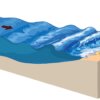Earthquakes can cause liquefaction of soil because during an earthquake the soil loses its strength or stiffness, and can result in failure and landslides.
Soil liquefaction describes a phenomenon whereby a saturated or partially saturated soil substantially loses strength and stiffness in response to an applied stress, usually earthquake shaking or other sudden change in stress condition, causing it to behave like a liquid.
Earthquakes and liquefaction
A major cause of liquefaction is the action of earthquakes. Earthquakes can effect a site and cause liquefaction in two ways:
- directly if a fault line crosses a site; and
- indirectly by seismic waves hitting a site.
Earthquakes also cause slope instability and the seismic stability of slopes can and should be evaluated and compensated for in earthquake-prone areas.
Static liquefaction
Liquefaction can also occur for other reasons, for instance, by slope steepening or by increasing pore water pressures within a fill mass. This ‘static’ liquefaction occurs when the underlying foundation is displaced. Static liquefaction can be subdivided by the results:
- flow liquefaction with rapid large deformations as soil loses strength as it is being loaded; and
- cyclic softening where deformations accumulate in a growing fatigue.
Land reclamations can be vulnerable to earthquake-related liquefaction and the dredging design should take measures to mitigate these impacts.
Whether caused by earthquakes or by static conditions, a wide range of soils are susceptible to liquefaction ranging from clean sands to non-plastic silts. This makes an assessment of liquefaction, soil behaviour studies, and testing a necessity.
If a fill is assessed as being susceptible to flow liquefaction then ground improvement is required and an analysis must be made to determine how much treatment and what kind of treatment should be implemented.







